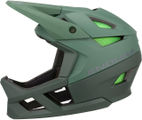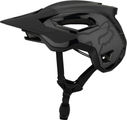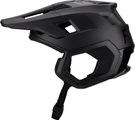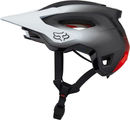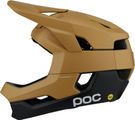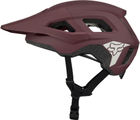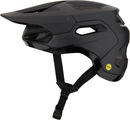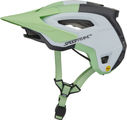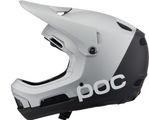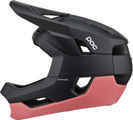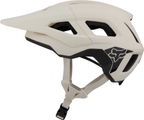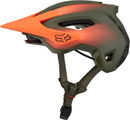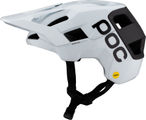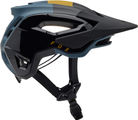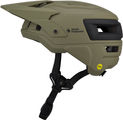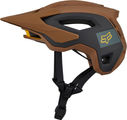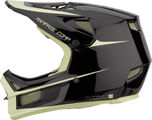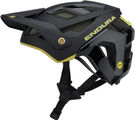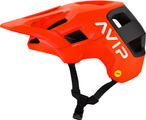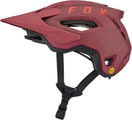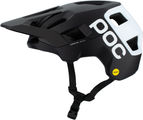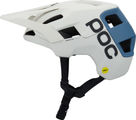MTB Helmets
OUR MTB Helmets RECOMMANDATIONS
Our Suggestions
Are you looking for a new MTB helmet, but want to find out more about modern models for mountain bikers first? Our guide will help lead you to the right helmet. View Helmet Guide
The Right Fit & Size
"There's a lid for every pot," or so the saying goes. That goes for your head, too. This is because helmet manufacturers offer their models in different sizes for different head shapes and circumferences. Almost all modern helmets are finely-adjustable in the head circumference, so that you can optimally adapt your helmet to your individual head shape. However, it’s clear that not every helmet fits every head... a good and comfortable fit is crucial in any case. In order to prevent painful pressure points from developing, your helmet should fit your head as evenly as possible overall and not just in certain areas. We show you how to measure your head circumference and adjust your helmet correctly in our "Ten Steps to the Right Bike Helmet” guide.
Half Shell or Full Face: The Right Design for You
Basically, MTB helmets are divided into open half shells and closed full-face helmets with a chin bar. The MTB half-shells are generally dropped lower on the sides and neck for more protection than their lightweight road bike siblings. They also often have fewer vents and use more material. Some models are available with small grilles over the vents – this keeps out not only insects, but also small twigs. Most MTB helmets also have a visor over the eyes to reduce glare from sunlight. Incidentally, it also looks better aesthetically. Since you usually sit in a less stretched out position on your MTB than on a road bike, the view to the front is not obstructed by the visor. In BMX, slopestyle and dirt riding, low round helmets without visors are common. Sometimes, these are affectionately and derisively referred to as a "dirt marble" or "piss pot helmet." Head protection definitely takes higher precedence than aerodynamics when it comes to mountain biking.
MTB Helmet Construction and Technology
High-quality mountain bike helmets are usually made of expanded polystyrene (EPS) under their shell using the so-called in-mold process. This ensures adequate shaping and a good fit. The EPS deforms on impact and absorbs energy. For some years now, the Swedish MIPS system (Multi-directional Impact Protection System), which many different helmet manufacturers use, has provided additional protection. You're probably familiar with the yellow MIPS layer in many high-end helmets. This reduces rotational forces that can damage the brain in the event of a fall by decoupling the helmet shell from the head: the MIPS layer slides back and forth inside the helmet by up to 1.5 cm, thereby reducing the risk of concussions and injuries to the brain. A further development is MIPS Integra, as POC Sportsuses it in the Kortal Race MIPS, or MIPS Spherical, as it is called byGiro. They are based on the same functional principle, but integrate this "floating layer" at different points in the helmet. Another relatively new design is Koroyd technology from Scottish manufacturer Endura. For this, in addition to a relatively thin layer of EPS, parallel polymer rolls deform on impact and absorb a lot of energy in the process. Just imagine hitting a pack of straws with your fist, and you'll understand the principle. Simple, but ingenious! Both technologies – MIPS and Koroyd – are used for the lightweight XC helmet as well as the stable DH helmet.
EN, ASTM and NTA – The Most Important Cycling Helmet Standards
In order for bicycle helmets to be allowed on the market in Europe, they must at least comply with the Euro Standard (EN) 1078 or EN 1080. Compliance with these standards is indicated by the CE mark. In order to comply with the standard, the bicycle helmets with two model heads of different weights must undergo a fall from a height of approximately 1.5 metres onto a flat surface and from a height of approximately one metre onto a ledge. The acceleration on the dummy head must not exceed 250 times the acceleration due to gravity (g). EN 1080, a standard specifically for kids’ helmets, is derived from EN 1078 . All other standards are additions – albeit useful ones! The US equivalent of EN 1078 is known as CPSC 1203, in New Zealand and Australia it is AS/NZS 2063. The American ASTM F1952-15 standard specifically certifies full-face helmets in the downhill and enduro sector and, unlike EN1078, also tests the chin bar of the helmet – an important decision-maker for gravity athletes. In the Netherlands, there is also NTA 8776, which is stricter than EN 1078 and is therefore often used as a standard for S-pedelec helmets in Germany.
Helmets for Cross-Country, Tour or Gravel Riding: Lightweight and Well-Ventilated
If cross-country is your main focus on a mountain bike or if you like to go on long tours across less-demanding terrain, a rather lightweight and well-ventilated half-shell helmet is usually the right choice. Despite the low weight, there are available many XC helmets, such as those from Specialized, Bell or Giro – also with MIPS. Particularly in the road category, many cross-country riders do without the visor – their riding position is almost as stretched out as on a road bike. That's why the visor on XC helmets is usually removable. When "tuned" like this, your new helmet can also be used for gravel biking. Oh, and one more thing – a mount for glasses is part and parcel of this category.
Helmets for All Mountain and Trail Riding: Plenty of Lateral Protection with Low Weight
Are you more into riding on gnarly and uneven trails, and feel at home spending long days on them? Then you need a helmet that protects you much more than a light XC helmet, while remaining well-ventilated and light. Models like the Specialized Ambush, POC Kortal (make sure to check out the combination with the Devour-Goggles!) or Endura MT500 (with Koroyd) compound these requirements by extending the back of the helmet further down, yet still provide a generous amount of ventilation. Again, MIPS is a good option with many providers for added protection. A visor is standard on such helmets and the boundaries to enduro are fluid.
For Endurists: Massive Half-Shell or Full-Face – and Space for Goggles
The MTB discipline Enduro combines extremes: sprints like in cross-country with long days in the saddle like on tour and with technically-demanding passages of a downhill course. Whether you go for a full-face helmet like those used in downhill or a stable half-shell like the ones used in all-mountain riding depends on many factors. Are you racing? What are the requirements set out by the race’s organizer? What are the routes and temperatures like? What about your personal safety needs? Basically, the more protection, the heavier and the worse the ventilation – not only around the head, but often also while breathing. If you opt for a half-shell, make sure you have as much side and rear coverage as possible. The Troy Lee Designs A3, for instance, has an extremely low back. Taking it another step further , such as the Fox HeadDropframe or Giro Tyrant: both also extend over the cheeks at the sides and thus protect the jaw, without using a chin bar. A full-face helmet offers even more protection. Some race organisers even demand it for special stages in Enduro races. No other helmet category offers so much safety. However, you should be aware that this kind of helmet is heavier, you sweat more under it and it makes breathing significantly more difficult. If you're going for full-face for an enduro race, choose one with a chin bar and side vents that sits relatively far from your face. Alternatively, you can go for a full-face helmet with removable chin bar. They offer a little less protection than a full-face helmet with a fixed chin bar, but significantly more than a pure half-shell: on the transfer, you ride without it and at the beginning of the stage, you simply attach the chin bar. The only disadvantage: you definitely need a backpack or a hip bag to carry the bar with you. Total enduro style is out. Speaking of enduro style: like in downhill, technical off-road terrain is often ridden while wearing goggles. Dedicated enduro helmets often offer an attachment for this, and allow you to slide the visor up with a flick of the wrist and stow the goggles there when they’re not needed for going uphill.
Downhill and Bike Park: Full Protection for the Head
Wherever you don't have to ride uphill under your own power, you can rely on maximum protection and go straight for the full-face helmet. Especially for downhill races there are no two opinions - a fullface and adequate protectors are mandatory! Another very good addition to full-face helmets is a neck brace, which stabilises the helmet in case of strong pitching movements and can significantly reduce the load on the cervical spine in case of a fall. The chin bar may sit close to the face for even greater protection. The ASTM-1952 standard mentioned at the beginning of this article proves the stability of the chin bar. By the way, if you think of heavy lead knight's armour when you think of downhill or park helmets, you've got the wrong idea: high-tech materials such as carbon are increasingly making their way into the market and helping to reduce weight. An example of this development is the Specialized S-Works Dissident DH ANGi MIPS. Despite full equipment and ASTM 1952, it only weighs about 1,000 grams thanks to the carbon matrix – making it interesting even for hardcore enduro bikers. A word about the fit: your full-face helmet shouldn’t wobble but not be too tight, especially in the cheek area. In the worst-case scenario, if you’re unconscious after a fall and first responders have to remove your helmet, removable cheek pads are a real advantage in terms of safety.
Special Case: Helmets for E-Mountain Bikers
Are you an E-mountain biker? The same applies to you as to your E-assist-less comrades: choose your helmet according to your area of use, but if in doubt, perhaps opt for the somewhat more stable helmet, since you will reach high speeds faster due to your extra power, especially uphill. Legally, you don't have to pay attention to anything out of the ordinary – unless you belong to the tiny minority that rides an E-mountain bike or a comparable bike as an S-pedelec – in which case helmet, insurance and road use requirements also apply to you. A helmet that complies with the strict Dutch NTA 8776, which was specially designed for E-bikes and S-pedelecs, is the latest recommendation. The legal requirements in Germany call for "only" a "suitable protective helmet" – but most experts agree that in the event of a dispute in court, a helmet according to NTA 8776 would be more likely to be deemed suitable than one according to EN 1078.
Helmet Care: When do you need a new helmet?
With most helmets, you can remove the inner padding and, if necessary, the cheek pads and wash them gently by hand or in the machine or replace them as needed – the same applies to small parts such as the visor or buckles. You can find all this under our "small parts” category. The outer shell is best cleaned with a soft cloth and lukewarm water. Nevertheless, a helmet is in some respects a part that can wear down: aging and UV light can both take a toll, so you should replace yours after five years at the latest – or if you have fallen and hit your head. Even if you do not see any damage on the surface, the interior may have suffered, which means a new helmet is required! Does that seem excessive and expensive to you? Remember, that thing is critical to your health. For a car, you wouldn't ask the mechanic if they could stuff the airbag back into the steering wheel.
